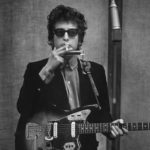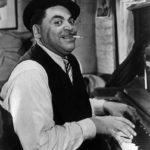FB is awful yes, often a cumulation of blown-up vanities, quite human but utterly distorted. It is overloading and underloading, overwhelming and underwhelming at the same time. Its dynamics devalue the contributions and it is often a fire that has to be rekindled again and again. Ein Feuer, das immer und nie ausgeht. FB could be much nicer if its construction would be different but with some patience and discipline it is possible to gain some coherent and valuable things from the communication with FB friends. I appreciate very much the posts of DON’s TUNES. The way DON’s TUNES gathers historical background information and composes concise insightful narratives from it, is a blessing.
Here are three examples from his postings on FB, one on Bob Dylan, one on Paul Butterfield and one on Fats Waller.
Bob Dylan
„While Bob Dylan hadn’t come to Newport planning to go electric, the sudden buzz over Paul Butterfield, and his increasing disdain for folk orthodoxy, inspired him to amp up. “He knew electricity was definitely the direction and he was going with that flow,” wrote Jim Rooney and Eric Von Schmidt in Baby Let Me Follow You Down: The Cambridge Folk Years. “When he heard the Butterfield Band the day before and saw the reaction of the crowd, it seemed that the time might be right to work up two or three songs to play on the evening concert.”
Dylan recruited Mike Bloomfield to hastily assemble an ad hoc outfit which rehearsed overnight on Saturday at a Newport mansion leased by George Wein. The group coalesced around Butterfield’s ace rhythm section, bassist Jerome Arnold and drummer Sam Lay, players who’d honed their chops with Little Walter and Howlin’ Wolf, and organist Barry Goldberg, who’d traveled from Chicago with Butter. Al Kooper had also come to Newport, but on his own as a paying customer. Shortly after his arrival, he was handed backstage passes, and was later deputized to play organ on “Maggie’s Farm” and bass on “Like a Rolling Stone.”
When Bloomfield first met Dylan in Chicago in 1963, he approached him like a headhunter. “I had heard his first album, and I went down [to Grossman’s club, the Bear] to cut Bob, to take my guitar and cut him, burn him, but he was a great guy. I mean we spent all day talking and jamming and hanging out…and any instinct I may have had to try and cut him, which is very common in Chicago…was immediately stopped, and I was just charmed by the man…I realized he was way more than a player and singer. He was a magician.”
-New England Public Radio
Photo: Bob Dylan, Recording Session. New York City, 1965. by W. Eugene Smith
Paul Butterfield
Remembering the harmonica legend Paul Butterfield (December 17, 1942 – May 4, 1987)
Paul Butterfield is an archetypal figure in American music, a young white man who played the blues with startling authenticity and projected through black music a figure both daring and romantic, an iconic blend of dedicated virtuoso and pugnacious street tough. B.B. King’s biographer Charles Sawyer saw him as a figure who went directly from boyhood to middle age, skipping adolescence altogether. Butter was only 22 when he cut his debut recordings, but he came across as startlingly mature, and his no-nonsense approach raised the stakes for everyone else. Barry Goldberg, the keyboard player who worked with Bob Dylan and was a founding member of the Electric Flag, says, “Paul’s whole vibe, his whole persona, was of greatness.” Songwriter Joel Zoss, who first met him in Chicago around 1963, told me, “To know Paul was to touch real greatness. You knew you were walking with a master.”
In a 1971 interview, Butterfield allowed that when Muddy Waters first invited him onto the bandstand, he wasn’t yet a master of much. “But everybody there was saying, ‘Yeah, go ahead man, out of sight!’ They were humoring me, but that was okay because if they had said, ‘Please, man, come on, stop,’ I might never have gone on.” In a joint interview with Waters and Butterfield that Downbeat featured as a cover story in 1969, Muddy remembered his young charge. “He wasn’t too good when I first noticed him, but he got good…And you always had this particular thing, this something that everybody don’t have, this thing you’re born with, this touch. ‘Cause you used to sing this little song and have the joint going pretty good. As soon as you’d walk in, I’d say ‘You’re on next, man’.”
Tom Reney – No Depression
Photo: Kathy Butterfield
Fats Waller
Remembering Fats Waller (May 21, 1904 – December 15, 1943)
One of jazz’s most irrepressible and influential figures, Thomas “Fats” Waller was a larger-than-life character who exuded elegance and wit in his piano and organ playing and who made jazz fun and accessible through his vocals and his comedic talents.
Waller was also a prolific songwriter, with many of his compositions becoming huge commercial successes. His technique and attention to decorative detail influenced countless jazz pianists including Art Tatum, Count Basie, and Thelonious Monk.
“Concentrate on the melody,” he advised. “If it’s good, you don’t have to shoot it out of a cannon. Jimmie Johnson taught me that. You got to hang onto the melody and never let it get boresome.”
Photo: Jazz Magazine Archives


